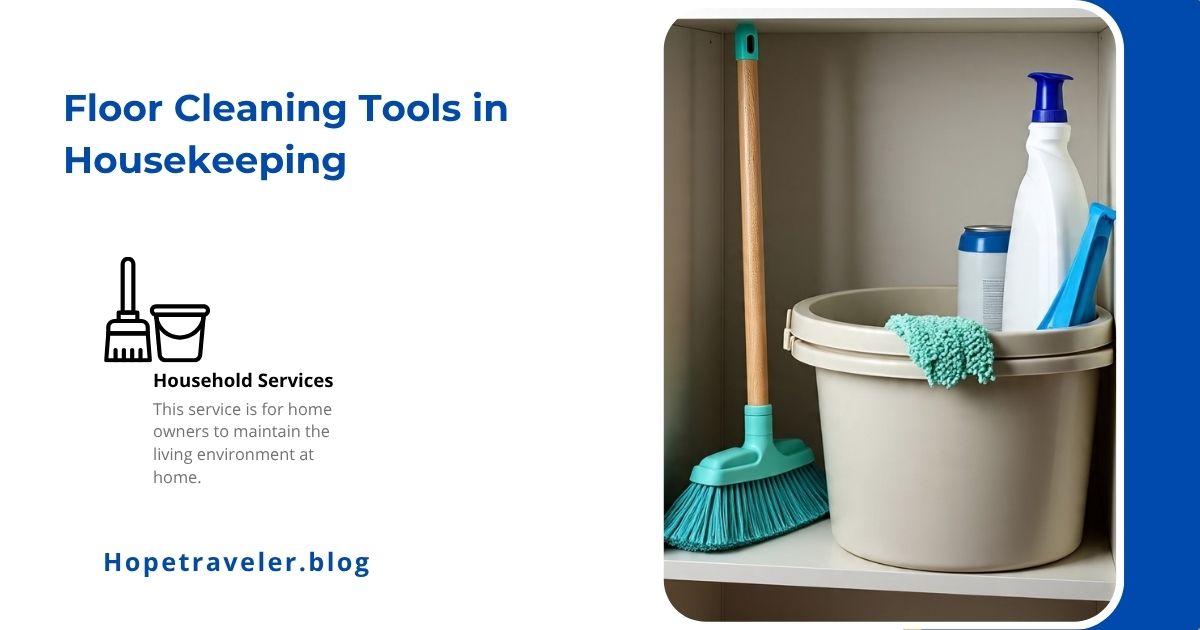Housekeeping is an essential part of maintaining cleanliness, hygiene, and an aesthetically pleasing environment, whether in hotels, offices, hospitals, or homes. One of the most crucial aspects of housekeeping is floor care, as floors are high-traffic areas that accumulate dirt, dust, stains, and germs. The right floor cleaning tools in housekeeping can make cleaning more effective, efficient, and safe. Understanding these tools, their uses, and proper maintenance is vital for professional housekeepers and even homeowners who want spotless and well-maintained floors.
Importance of Floor Cleaning in Housekeeping
Floors set the tone for the overall appearance of any space. A clean, shiny floor can create a positive impression, while a dirty or dull floor can make even a well-decorated room look unkempt. In commercial and hospitality settings, clean floors also reflect the quality of service and adherence to hygiene standards. From removing dust and dirt to polishing and disinfecting, floor cleaning is a daily necessity in housekeeping operations.
Categories of Floor Cleaning Tools
Floor cleaning tools in housekeeping can be broadly divided into manual tools and mechanical/electrical equipment. Both have their advantages and are often used in combination for best results.
1. Manual Floor Cleaning Tools
These are tools that rely on human effort rather than electricity or battery power. They are cost-effective, easy to use, and suitable for both small and large spaces.
a) Brooms
- Soft brooms: Used for sweeping fine dust on smooth surfaces like tile or laminate flooring.
- Hard brooms: Designed for rough surfaces such as concrete or outdoor areas.
- Brooms are lightweight, easy to store, and essential for removing loose dirt before wet cleaning.
b) Dustpans
- Often used with brooms to collect swept debris.
- Available in both handheld and long-handled designs for convenience.
c) Mops
- String mops: Good for absorbing spills and cleaning large wet areas.
- Flat mops: Ideal for light cleaning and quick drying.
- Sponge mops: Effective for scrubbing and absorbing liquid.
- Microfiber mop heads are highly effective at trapping dirt and bacteria.
d) Mop Buckets and Wringers
- Buckets with built-in wringers help control the amount of water on the mop, preventing excess moisture that can damage certain floors.
- Some have wheels for easy movement.
e) Dust Mops
- Used for dry mopping large areas, such as hallways or lobbies.
- They collect dust, hair, and small particles without the need for water.
f) Floor Scrub Brushes
- Equipped with stiff bristles to remove stubborn dirt, grime, or stains from surfaces.
- Available in handheld or long-handle designs for different cleaning needs.
2. Mechanical and Electrical Floor Cleaning Equipment
These tools save time and reduce physical effort, making them suitable for large facilities and heavy-duty cleaning.
a) Vacuum Cleaners
- Designed for carpets, rugs, and hard floors.
- Models include upright, canister, backpack, and robotic vacuums.
- HEPA filter vacuums help improve indoor air quality.
b) Floor Scrubbers
- Automatic machines that dispense cleaning solution, scrub the floor, and vacuum up the dirty water.
- Ideal for commercial spaces with heavy foot traffic.
c) Floor Buffers/Polishers
- Used to maintain shine and smoothness on floors like marble, vinyl, and hardwood.
- High-speed burnishers can restore a glossy finish quickly.
d) Steam Cleaners
- Use hot steam to clean and sanitize floors without harsh chemicals.
- Effective in killing bacteria and loosening dirt.
e) Carpet Cleaners (Extractors)
- Designed for deep-cleaning carpets using water, detergent, and suction to remove embedded dirt and stains.
Choosing the Right Floor Cleaning Tools
When selecting tools, housekeepers should consider:
- Type of flooring (wood, tile, marble, vinyl, carpet).
- Frequency of cleaning needed.
- Budget and storage space available.
- Ease of maintenance for the tools themselves.
- Health and safety factors, such as ergonomics and chemical use.
Maintenance of Floor Cleaning Tools
Proper care extends the lifespan of tools and ensures hygienic cleaning results:
- Wash mop heads after each use and dry them completely to prevent mold.
- Empty and rinse buckets to avoid residue buildup.
- Clean vacuum filters regularly for optimal suction.
- Check for wear and tear on brooms, brushes, and mop handles.
- Store tools in a dry, well-ventilated area.
Best Practices for Floor Cleaning in Housekeeping
- Sweep or vacuum before mopping to remove loose debris.
- Use appropriate cleaning solutions for each floor type.
- Avoid excessive water on wood or laminate floors.
- Disinfect high-traffic areas regularly.
- Rotate between deep cleaning and maintenance cleaning to keep floors looking their best.
Conclusion
Efficient housekeeping relies heavily on having the right floor cleaning tools and using them correctly. Whether it’s a simple broom and mop for a small home or advanced mechanical equipment for large commercial buildings, the choice of tools directly impacts cleaning quality, time efficiency, and hygiene standards. With proper selection, use, and maintenance, housekeepers can ensure that floors remain spotless, safe, and inviting.
